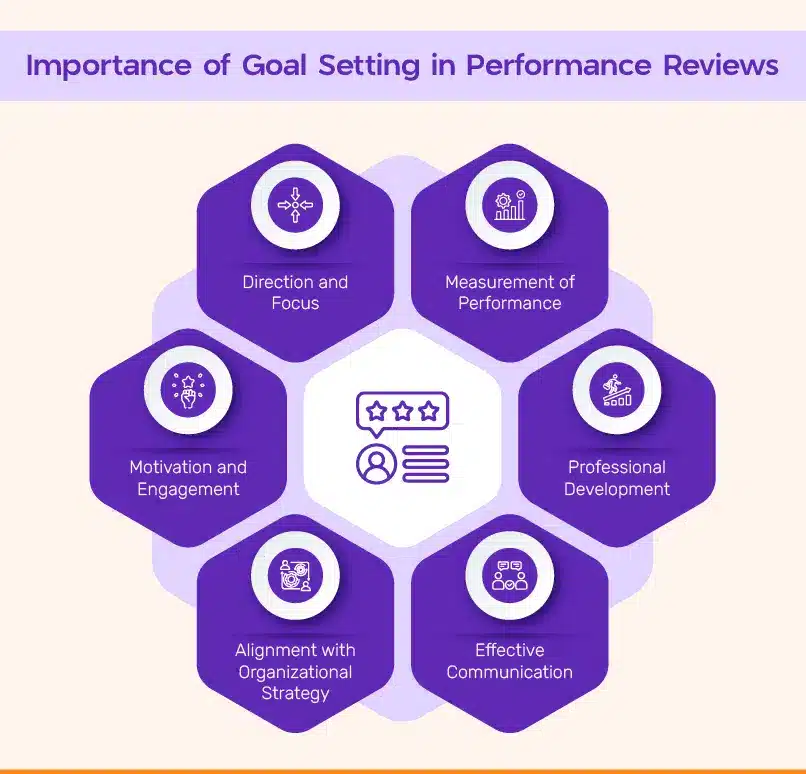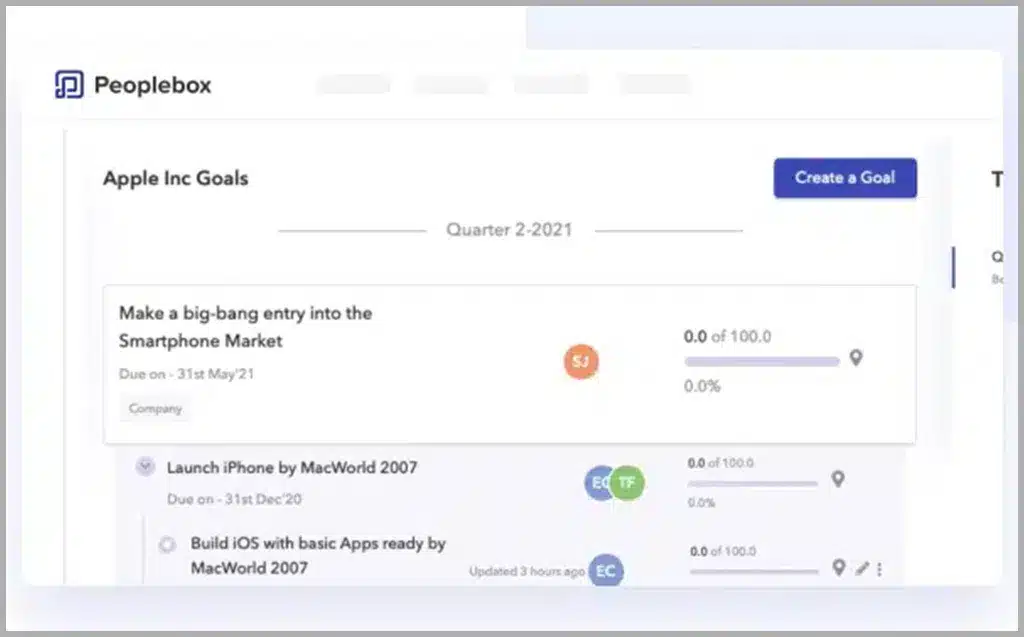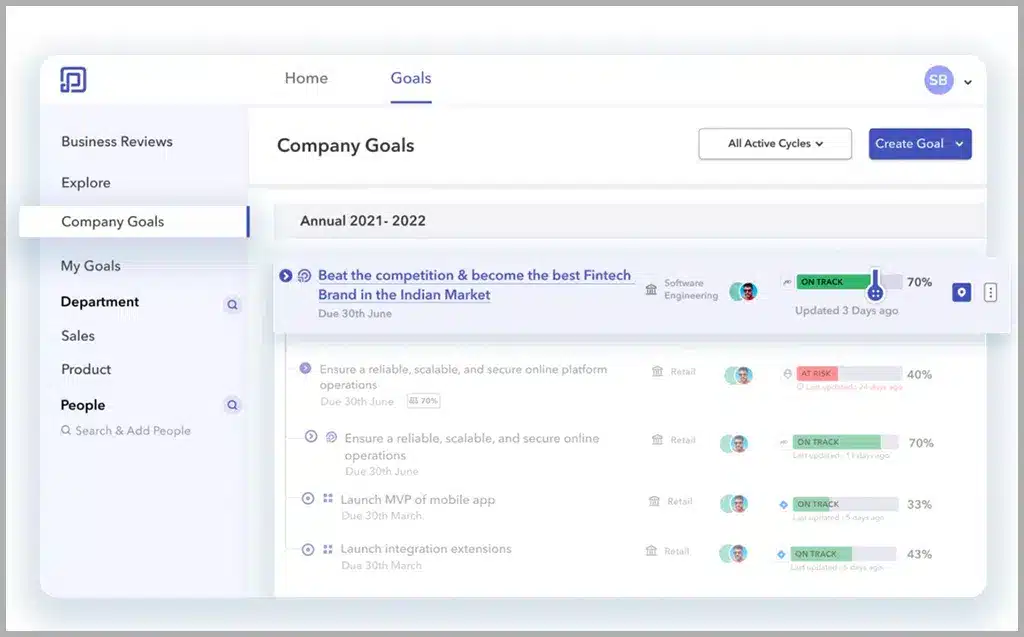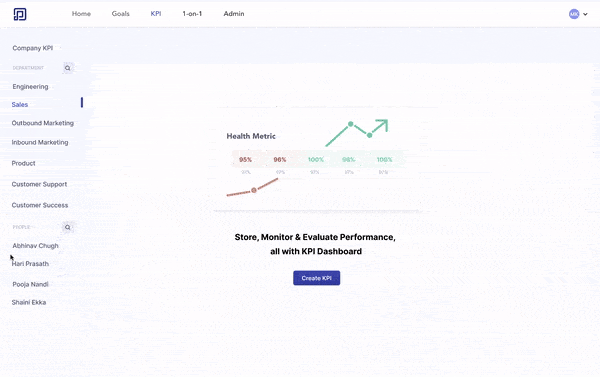Master the art of goal-setting for performance reviews to unlock professional and organizational excellence.
Time and again, multiple studies have proven that organizations with a strong focus on goal-sеtting arе morе likеly to outpеrform thеir pееrs in tеrms of ovеrall profits. Whеn it comеs to pеrformancе rеviеws, thе ability to еstablish and achieve goals is intеgral to fostеring both pеrsonal growth and organizational growth.
In this blog post, wе will discuss how you can sеt and hеlp your tеams achiеvе thеsе goals, unlocking a pathway to еnhancеd profеssional dеvеlopmеnt and organizational еxcеllеncе.

Why is Setting Goals for a Performance Review important?
Goal-setting plays a crucial role in performance management due to its multifaceted impact on individual employees and an organization’s overall success. Here are several reasons why goal-setting is deemed essential in the context of performance reviews:

1. Direction and Focus
Individual Level: Career goals give employees a clear sense of direction and purpose. They act as a roadmap, guiding individuals on what needs to be accomplished and how to prioritize their efforts.
Organizational Level: Aligned individual goals contribute to a collective focus on organizational objectives. This alignment ensures that everyone works towards common goals, fostering unity and synergy across the workforce.
2. Measurement of Performance
Individual Level: Well-defined professional goals offer quantifiable metrics for assessing individual performance. Measurable goals allow for an objective evaluation of achievements, areas of improvement, and overall contributions.
Organizational Level: Aggregated individual goals provide a measurable way to evaluate the organization’s progress. It facilitates a comprehensive understanding of how well the workforce collectively contributes to strategic objectives.

3. Motivation and Engagement
Individual Level: Setting and achieving goals can be a powerful motivator. It gives employees a sense of accomplishment, boosts morale, and encourages a proactive approach to work.
Organizational Level: A workforce driven by the achievement of meaningful goals is inherently more engaged. This heightened engagement translates into increased productivity, innovation, and a positive organizational culture.
4. Professional Development
Individual Level: Goals serve as a tool for personal and professional development. They encourage employees to acquire new skills (technical skills, leadership skills, soft skills, communication skills, etc), enhance existing ones, and pursue continuous learning.
Organizational Level: A workforce that is continually improving and developing its skill set contributes to the overall adaptability and competitiveness of the organization.
Setting effective development goals is a pivotal factor in fostering growth. To guide you in this crucial aspect, we’re providing a curated list of development goal examples. These goals, whether at the individual or organizational level, act as catalysts for personal and professional development.
5. Alignment with Organizational Strategy
Individual Level: By aligning individual goals with organizational objectives, employees become integral contributors to the company’s strategic vision.
Organizational Level: The collective pursuit of aligned goals ensures that every individual’s efforts are directed toward achieving the overarching mission and vision of the organization. Are you wondering what goes into mastering strategy execution? Check out our blog post.
6. Effective Communication
Individual Level: The goal-setting process facilitates open communication between employees and managers during performance reviews. It provides a platform to discuss expectations, challenges, and potential areas for growth.
Organizational Level: Transparent communication about goals fosters a culture of trust and collaboration. It encourages a free flow of ideas and insights, promoting a supportive and communicative work environment.
In a nutshell, it creates a framework that not only evaluates past performance but also shapes future achievements, contributing to a dynamic and thriving workplace ecosystem.
Now that we’ve established the importance of goals for a performance review let us look at how the traditional goal-setting process differs from the framework used by the giants at Google and LinkedIn— OKRs.

What Is The Difference Between Traditional Goal-Setting and OKRs?
Objectives and Key Results (OKRs) is a goal-setting framework that gained popularity through its successful implementation at companies like Google. OKRs consist of two main components: Objectives, which are the qualitative, inspirational goals a company aims to achieve, and Key Results, which are specific, measurable outcomes that indicate progress towards those objectives. For example, the marketing team aims to have 1,000 total subscribers, and the key results are to increase the email open rate by 20% and reduce the churn rate to 2%.
OKRs are typically set across multiple cadences and are designed to be ambitious yet achievable, fostering innovation and continuous improvement.
Here’s how OKRs differ from a traditional goal-setting process:
| Aspect | Traditional Goal Setting | OKRs (Objectives and Key Results) |
| Clarity and Precision | Often vague and subjective goals. | Emphasizes clear, measurable objectives with specific key results. |
| Measurability | Measurement criteria may be ambiguous. | Key Results are quantifiable, providing a clear yardstick for success. |
| Time Frame | Often long-term goals with infrequent performance review cycles. | Shorter-term objectives with frequent check-ins and iterative adjustments. |
| Adaptability | Limited flexibility to adapt to changing priorities. | Encourages agile adaptation through regular review and adjustments. |
| Alignment | Alignment with organizational objectives may be unclear. | Prioritizes alignment, ensuring that individual and team objectives support overarching goals. |
| Transparency | Goal-setting and progress tracking may lack transparency. | Promotes transparency through visible objectives and measurable results, fostering collaboration. |
| Motivation | Success may be subjective, leading to a lack of motivation. | Tangible results and achievements boost motivation by providing a clear sense of accomplishment. |
| Feedback Mechanism | Infrequent feedback cycles may hinder timely recognition and improvement. | Facilitates continuous feedback, enabling timely recognition of achievements and addressing challenges. |
New to OKRs? The journey can be both exciting and daunting. To simplify the process, we’ve compiled strategies to assist you in successfully rolling out OKRs for the first time.
Advantages of OKRs in Performance Reviews
The adoption of OKRs in performance reviews brings about a paradigm shift in the way organizations evaluate and enhance employee performance. Here are some notable advantages:
1. Measurable Outcomes Lead to Tangible Results
OKRs drive a results-oriented culture by requiring quantifiable Key Results. This focus on measurable outcomes not only provides clarity on success but also motivates individuals and teams by offering a tangible sense of achievement.
2. Alignment and Transparency Foster Collaboration
OKRs promote alignment by ensuring that individual and team objectives are in sync with overarching company goals. This alignment, coupled with transparency in goal-setting and progress tracking, creates a culture of collaboration where everyone understands their contribution to the larger picture.
3. Continuous Feedback Enhances Performance
Regular check-ins and reviews integral to the OKR methodology facilitate continuous feedback. This iterative process enables timely recognition of achievements, identification of obstacles, and adjustments to ensure that teams stay on course.
4. Agile Adaptation to Changing Priorities
In a dynamic business environment, priorities can shift rapidly. OKRs are different from regular KPIs and allow organizations to adapt swiftly by revisiting and realigning objectives based on evolving circumstances. This flexibility is a stark contrast to the rigid nature of traditional goal-setting.
If you’re ready to harness the power of OKRs for hypergrowth, download our ebook, ‘Crafting Hypergrowth: A Guide to Effective OKRs for Startups.’ Designed for leaders aiming to drive exceptional business results, this ebook provides insights, strategies, and over 100+ customizable OKR templates crafted specifically for hyper growth startups.

While traditional goal-setting methods have served as a foundation for organizational success, the adoption of OKRs represents a transformative leap toward achieving performance excellence. The clarity, measurability, and adaptability embedded in the OKR framework make it a powerful tool for businesses seeking agility and innovation.
How To Use OKRs To Tie Individual Goals To Business Success?
When it comes to organizational excellence, aligning individual goals with overarching business objectives is crucial. OKRs provide a strategic framework to connect individual contributions to broader business success seamlessly. Let’s take a quick example to see how.
1. Set Clear and Ambitious Objectives
Define overarching business objectives that articulate the organization’s strategic priorities. These objectives should be clear, inspirational, and ambitious, setting the tone for the company’s goals within a specific timeframe.
Example:
Business Objective: Increase Market Share by 15% in the Next Quarter.
2. Establish Key Results for Each Objective
Break down the business objectives into specific, measurable Key Results. These should serve as quantifiable milestones that indicate progress toward achieving the defined objectives. Each Key Result should be challenging yet attainable.
Example:
Key Result 1: Launch Two New Product Features to Boost Customer Engagement.
Key Result 2: Expand Sales Outreach, Resulting in a 20% Increase in Customer Acquisition.
3. Cascade Objectives to Individual Goals
Align individual goals with the established Key Results. Each team member’s objectives should contribute directly to the achievement of specific Key Results, fostering a direct connection between their work and the overall success of the organization.
Example:
Individual Goal: Enhance Customer Support Responsiveness.
Contribution to Key Result 1: Achieve 90% Customer Satisfaction through Swift Issue Resolution.
Contribution to Key Result 2: Provide Product Education to Existing Customers, Increasing Renewal Rates.
Peoplebox.ai OKR platform lets you see how individual and team goals align with the entire organization’s goal seamlessly.

4. Establish Metrics for Measurement
Define metrics and benchmarks to measure progress regularly. These should be quantifiable and easily tracked, allowing for a transparent evaluation of individual and collective performance against the defined Key Results.
Example:
Metrics: Monitor Customer Satisfaction Scores, Average Response Time, and Renewal Rates.
5. Encourage Regular Check-ins and Feedback
Implement a regular check-in cadence to review progress and provide constructive feedback. This iterative process allows for course corrections, ensuring that individuals stay aligned with evolving business priorities.
Example:
Check-in Frequency: Bi-weekly team meetings to assess progress, discuss challenges, and strategize for upcoming tasks.
6. Foster a Culture of Continuous Improvement
Use the insights gained from OKR assessments to identify areas of improvement. Encourage a culture that values learning and adaptability, where individuals are empowered to refine their goals based on evolving business needs.
Example:
Continuous Improvement: Conduct quarterly reviews to analyze the effectiveness of individual contributions and identify opportunities for skill development.
By implementing this structured approach to goal alignment, organizations can harness the power of OKRs to tie individual goals to business success seamlessly.
Setting Goals for Performance Reviews
Follow this step-by-step process to set impactful and achievable goals for your next performance review.
Evaluating Your Current Performance
Conducting a Comprehensive Self-Assessment
Before embarking on any journey of improvement, gaining a comprehensive understanding of one’s current performance is paramount. As an HR manager or team leader, facilitate a thorough self-assessment to help employees identify strengths, weaknesses, and areas for growth. This process may involve reflecting on past achievements, seeking feedback from colleagues, and analyzing relevant performance metrics.
Identifying Strategic Areas for Improvement
Analyzing Job Responsibilities and Key Performance Indicators (KPIs)
Guide employees in understanding their roles by analyzing job responsibilities and identifying key performance indicators (KPIs). This step ensures alignment of personal goals with organizational objectives. For instance, for a sales professional, key areas might include meeting sales targets, client satisfaction, and lead generation.
Aligning Skills and Competencies with Success
Encourage employees to evaluate their professional skills and competencies in relation to their roles. Help them identify areas where improvements can enhance their performance. For example, if effective communication is a key competency, suggest workshops or training to refine this skill.
Check out our blog post for Performance Review Competencies Examples to Excel in 2024.
Crafting Clear and Measurable Performance Review Goals
Developing Specific and Ambitious Objectives
Assist employees in crafting clear and ambitious objectives that align with organizational priorities. For instance, if the organization aims to enhance customer satisfaction, guide them in formulating an objective like “Deliver exceptional customer service through streamlined communication channels.”
You can check out our exclusive blog post on 20+ performance management goals examples for inspiration!
Defining Key Performance Indicators (KPIs) for Precision
Specify Key Performance Indicators (KPIs) that align with your objectives. If your goal is to increase project efficiency, a KPI could be “reduce project completion time by 15% in the next quarter.”
Peoplebox.ai enables setting individual, team, and company KPIs, tracked seamlessly in weekly, monthly, quarterly, or yearly views with the KPI Board.

Building an Action Plan
Outlining Step-by-Step Actions for Goal Achievement
Assist in developing a detailed action plan, outlining specific steps to achieve goals. Help employees break down larger objectives into manageable tasks. For instance, if the goal is to enhance project management skills, actions might include enrolling in project management courses and practicing new methodologies. Here are some examples and templates of individual development plans to get you started.
Identifying Necessary Resources and Support
Determine the resources and support needed for goal attainment. This could involve securing a mentor for guidance, accessing training materials, or collaborating with colleagues. A table outlining required resources, responsible parties, and timelines can provide clarity.
Effective Communication of Goals
Articulating Goals Clearly to Supervisors
Communicate your goals clearly to supervisors. Ensure they understand the objectives, the rationale behind them, and the potential benefits. This can facilitate alignment between personal and organizational goals.
Collaborating on Goal Alignment with Teams
Goal-setting is a collaborative process. Collaborate with team members to align individual goals with team objectives. This fosters a cohesive work environment where everyone is moving in the same direction. A table displaying individual and team goals can visually highlight alignment.
Progress Monitoring and Adjustment
Establishing a Goal Tracking System
Implement a goal tracking system to monitor progress. This system could include regular check-ins, progress reports, and visual aids. Having a visual representation of progress enhances accountability.
If this seems like a lot, we highly recommend opting for a OKR management platform to make the whole process a breeze.

Regular Check-Ins for Goal Assessment
Conduct regular check-ins to assess goal progress. This provides an opportunity to celebrate achievements, address challenges, and make adjustments as needed. Consider scheduling monthly or quarterly reviews to stay on track.
Celebrating Success and Learning from Setbacks
Recognizing and Rewarding Goal Attainment
Acknowledge and celebrate the achievement of goals. Recognition can be both intrinsic (personal satisfaction) and extrinsic (public acknowledgment or rewards). This boosts motivation and reinforces a culture of goal attainment.
Gaining Insights from Unmet Goals for Future Improvement
When goals are not met, view it as an opportunity for learning and improvement. Analyze setbacks, identify root causes, and adjust strategies for future goals. This continuous improvement mindset contributes to long-term success.
Employee Performance Review Goals Examples
1. Employee Performance Goal for Collaboration and Teamwork
Objective: Foster a Culture of Collaborative Excellence
Key Result 1: Achieve a 20% increase in cross-functional project participation, measured by the number of employees engaged in projects outside their core responsibilities.
Key Result 2: Conduct monthly team-building activities to enhance interpersonal relationships, aiming for a 15% improvement in team cohesion, as measured by post-activity surveys.
Key Result 3: Successfully complete two collaborative learning initiatives, measured by the development of cross-functional skills and knowledge.
This employee performance goal not only emphasizes increased collaboration but also quantifies it through measurable key results, promoting a culture of teamwork and shared success.
2. Performance Review Productivity Goals
Objective: Enhance Individual Productivity for Organizational Efficiency
Key Result 1: Increase personal task completion rate by 25%, measured through project management tools and task tracking systems.
Key Result 2: Streamline workflow processes by identifying and implementing two efficiency improvements, resulting in a 15% reduction in task turnaround time.
Key Result 3: Achieve a 10% improvement in project delivery timelines, measured by comparing estimated vs. actual project completion dates.
This OKR-based work performance goal focuses on tangible outcomes, aligning individual productivity with broader organizational efficiency objectives, thereby contributing to overall business success.
3. Performance Evaluation Goals for Professional Development
Objective: Cultivate a Continuous Learning Mindset for Professional Growth
Key Result 1: Complete three industry-relevant certifications or training programs, measured by certification completion records.
Key Result 2: Actively participate in at least two cross-functional projects to gain exposure to diverse skill sets and perspectives.
Key Result 3: Conduct a quarterly self-assessment to identify and address skill gaps, resulting in a 20% increase in identified and improved competencies over the performance period.
This performance goal in OKR format underscores the importance of ongoing learning and development, aligning individual professional growth with the organization’s commitment to staying ahead in a rapidly evolving business landscape.
Effective Performance Review Goal Setting with Peoplebox.ai
Peoplebox.ai seamlessly incorporates the power of OKRs to enhance performance reviews. This integration fosters alignment, transparency, and accountability, making goal management straightforward and effective. Peoplebox.ai is a valuable asset, simplifying the complexities of OKRs with an intuitive platform. Extensive support for over 50 ready-to-use integrations across databases, SaaS applications, HRMS, and communication platforms makes Peoplebox.ai a versatile and efficient choice for HR leaders to quickly access and track goals.
By promoting unity in objectives, ensuring transparency, and redefining accountability, Peoplebox.ai empowers teams to exceed goals with clarity and purpose. In the ever-evolving business landscape, Peoplebox.ai emerges as a strategic partner, facilitating a seamless journey toward performance excellence.
Ready to transform your performance reviews? Request a Peoplebox.ai demo today!






